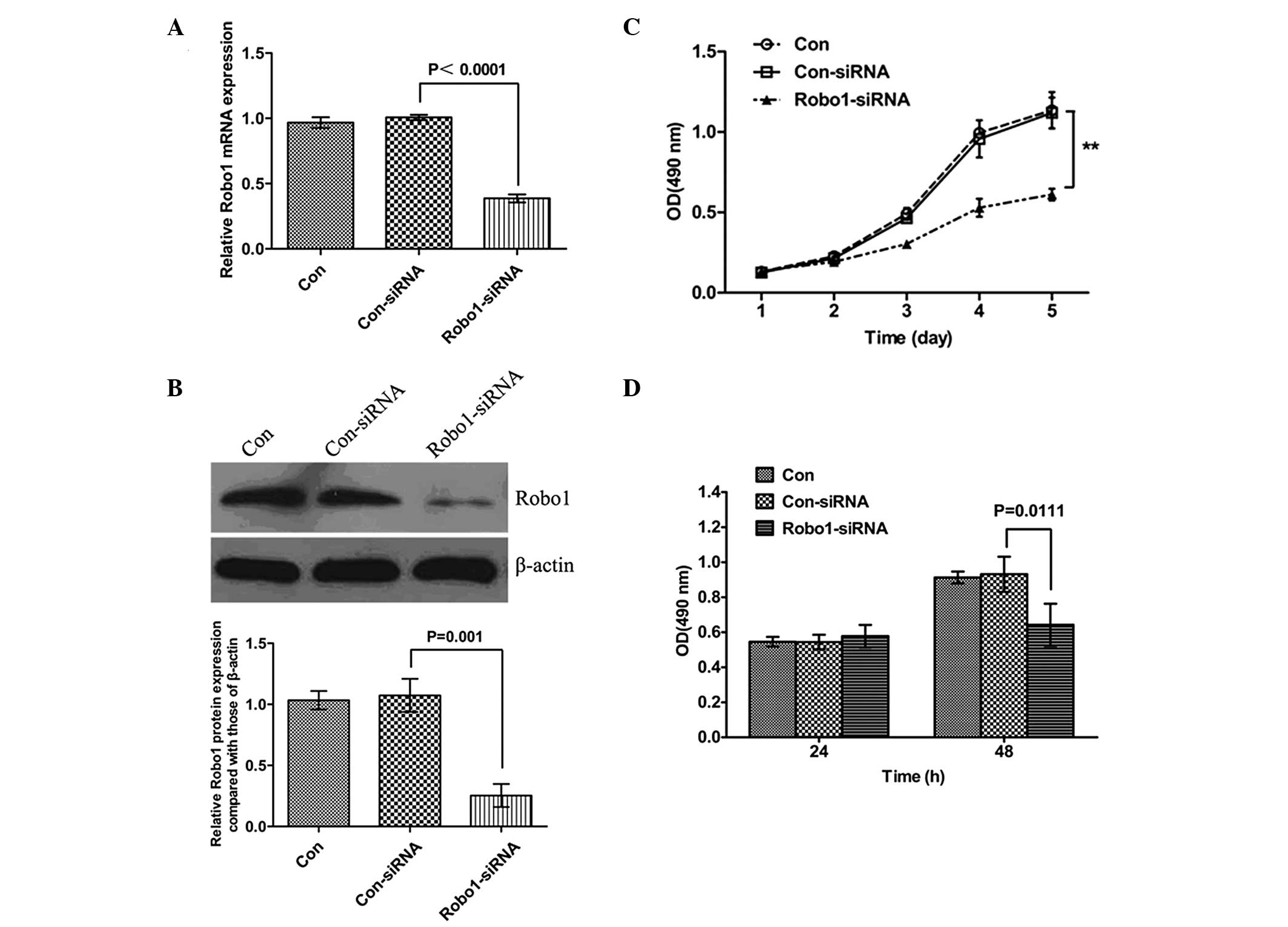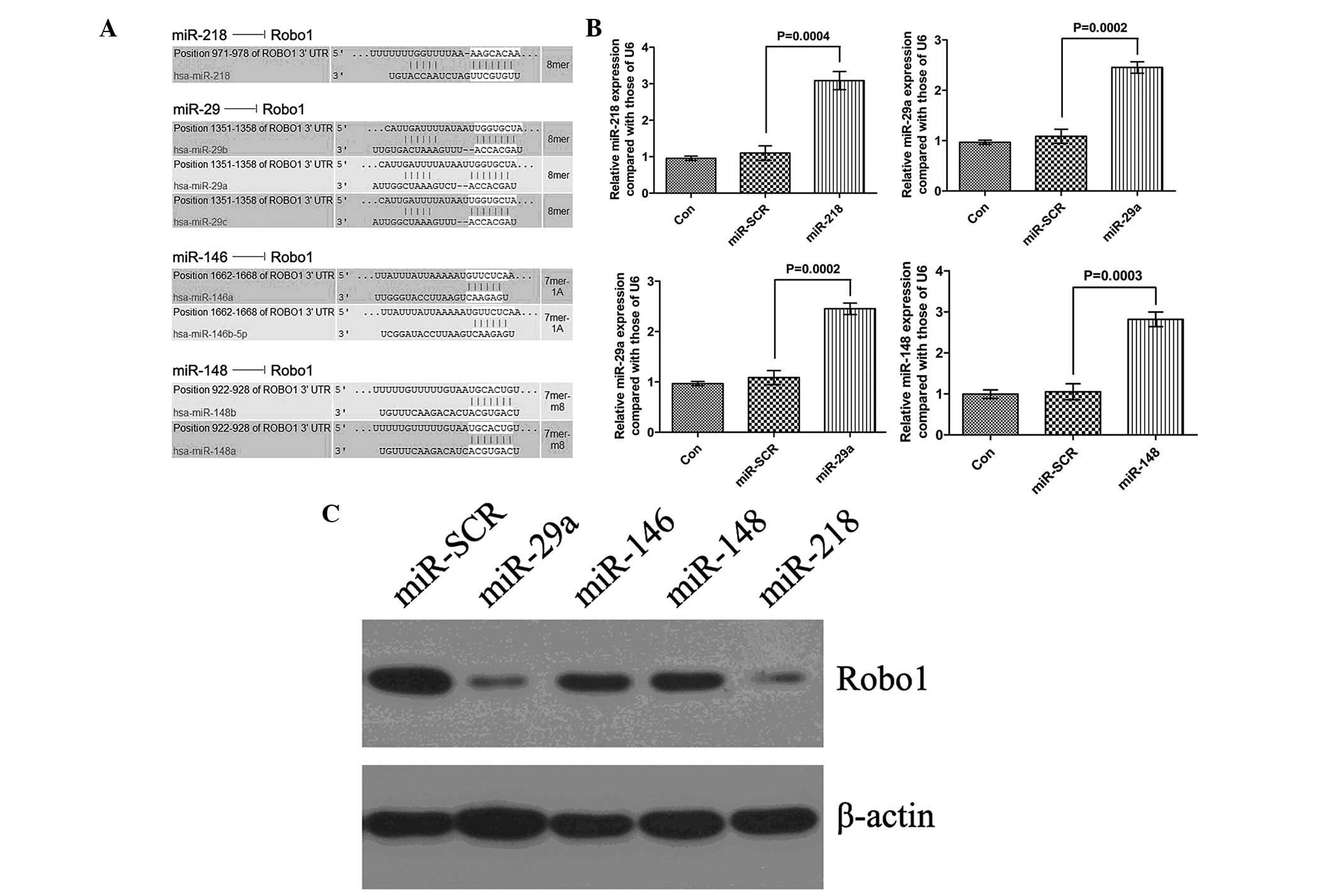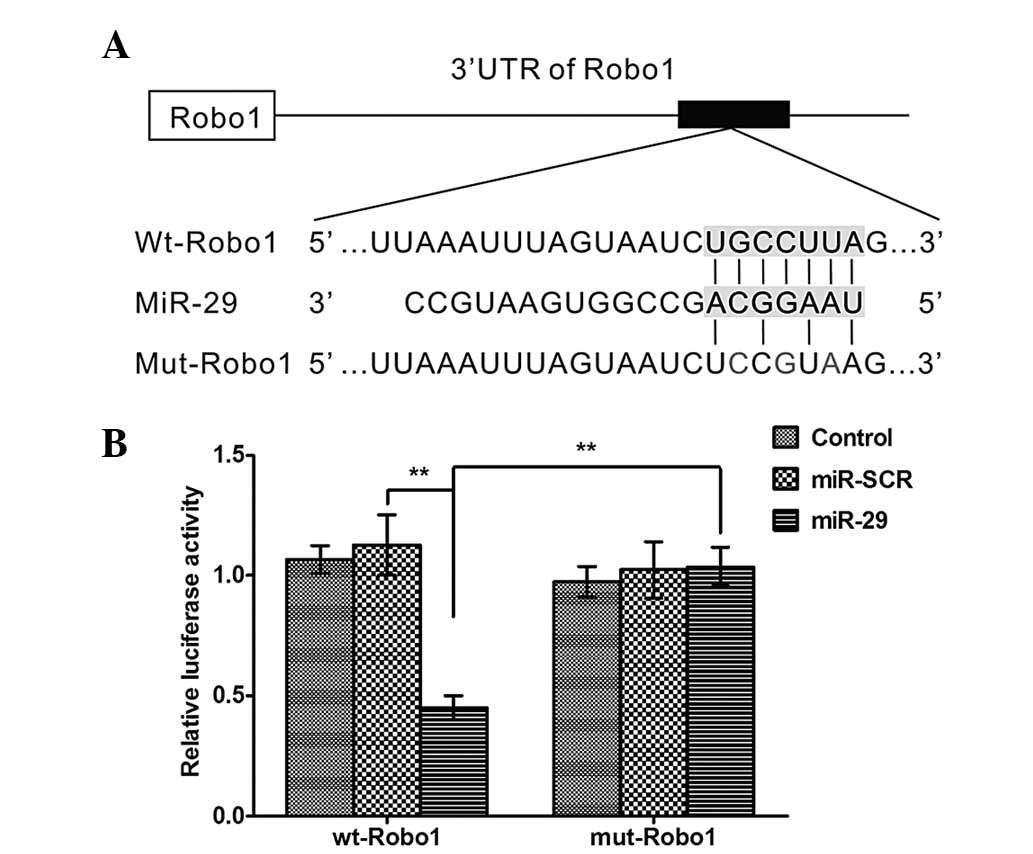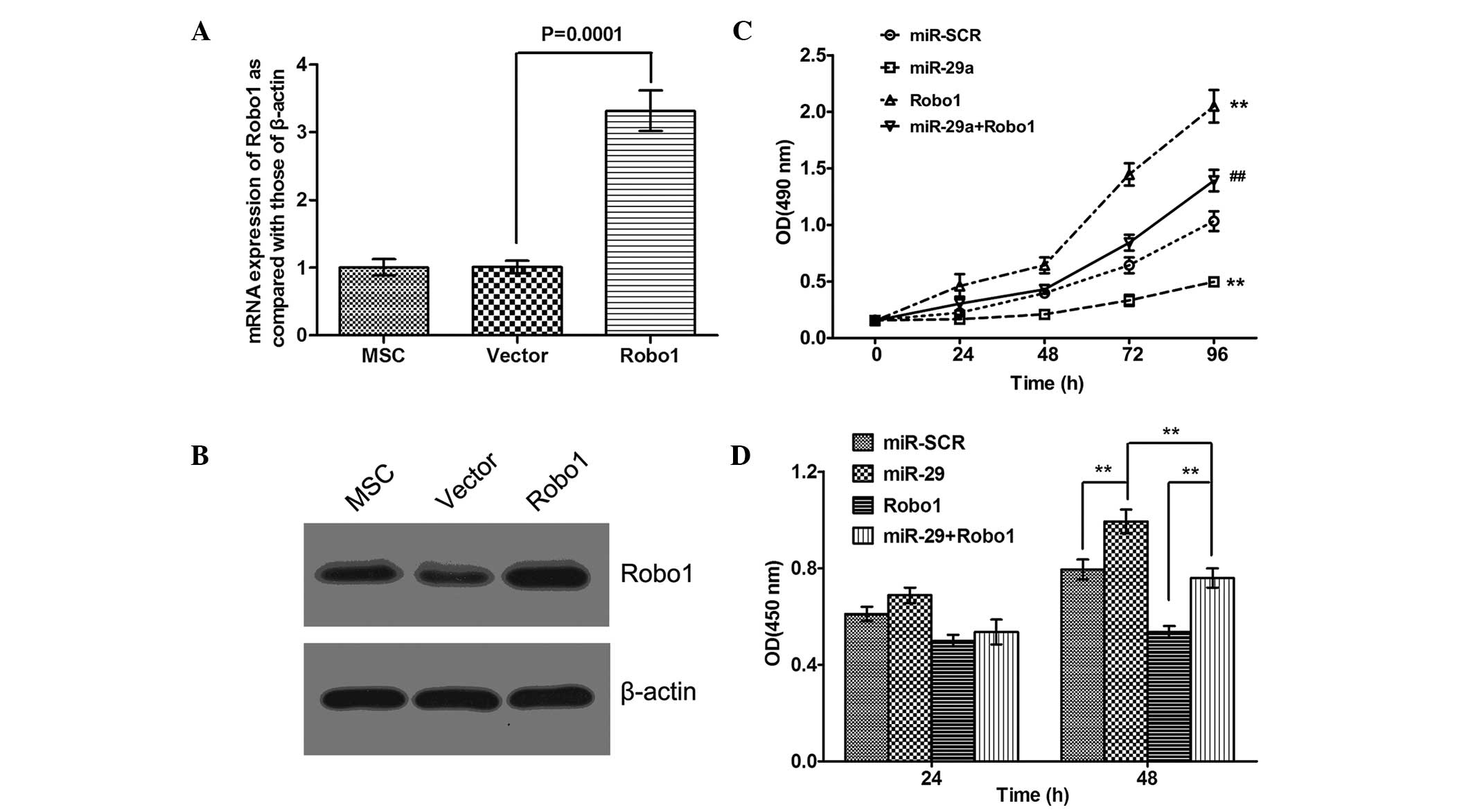MicroRNA‑29a inhibits mesenchymal stem cell viability and proliferation by targeting Roundabout 1
- Authors:
- Published online on: August 5, 2015 https://doi.org/10.3892/mmr.2015.4183
- Pages: 6178-6184
Abstract
Introduction
Stem cell transplantation has been investigated extensively as a therapeutic approach to regenerate tissues following injury (1). Mesenchymal stem cells (MSCs), which can be readily isolated and expanded, have neurogenic, chondrogenic, adipogenic, osteogenic and myogenic properties under specific differentiating conditions (2). Furthermore, MSCs are genetically stable with have a low risk of immune rejection and, therefore, are often used as seeding cells in tissue engineering and in stem cell therapy (3).
The ability to accurately regulate of cell fate determination is a prerequisite for the future therapeutic use of MSCs. MicroRNAs (miRNAs), a class of small non-coding RNAs, negatively regulate the expression of a variety of genes (4). miRNAs affect diverse cellular pathways by inducing RNA interference-based mechanisms at a post-transcriptional level (5). Based on the complicated association between miRNAs and the mRNA 3′-untranslated region (UTR), several online tools have been developed, including TargetScan, PicTar and TargetRank, which provide miRNA target predictions based on sequence complementarity in the optimal base-pairing of miRNA to the seed region and sequence conservation (6–8).
Roundabout 1 (Robo1) is expressed in multiple cell types, including embryonic stem cells, cadiocytes, vascular endothelial cells and MSCs (9,10). In addition, Robo1 is crucial in the regulation of cell proliferation, migration and differentiation (11,12). Inhibition of the expression of Robo1 has a suppressive effect on cell proliferation (11,13), however, the role of Robo1 in MSCs remains to be fully elucidated.
In order to identify novel miRNAs, which target Robo1, the present study used bioinformatic predications and confirmed the association between miR-29a and Robo1 by performing luciferase reporter assays.
Materials and methods
Cell transfection
Human MSCs were purchased from the American Type Culture Collection (Manassas, VA, USA) and were cultured in RPMI-1640 medium (Invitrogen Life Technologies, Carlsbad, CA, USA) supplemented with 10% fetal bovine serum (Gibco-BRL, Carlsbad, CA, USA) at 37°C in a humidified atmosphere with 5% CO2. To achieve overexpression of miR-29a, the cells were transfected with an miR-29a lentivirus (Genepharma Co., Ltd., Shanghai, China) using Lipofectamine 2000 (Invitrogen Life Technologies). The overexpression of Robo1 was achieved using a Robo1 open reading frame-expressing clone (GeneCopoecia, Guangzhou, China). The cells were plated in 6-well plates or 96-well plates, transfected and incubated at 37°C for 24 or 48 h prior to their use in subsequent assays or for RNA and protein extraction.
Construction of lentiviral vectors overexpressing miR-29a and Robo1
To produce a lentivirus expressing mature miR-29a, the pre-miRNA sequence was synthesized and a control scrambled construct (control RNAi) with no homology to the human genome was designed (5′-AAT GTA CTG CGC GTG GAG A-3′). The sequences were cloned into the HpaI and XhoI sites of pGCSIL-green fluorescent protein (GFP) (GeneChem, Shanghai, China) to produce the pGCSIL-GFP-miR-29a or pGCSIL-GFP-control, respectively. Small interfering (si)RNA targeting Robo1 was purchased from Auragene Bioscience, Inc. (Changsha, China).
Lentivirus production, titration and infection
To produce the miR-29a and the control lentivirus, the plasmids encoding either miR-29a or the control scrambled sequence were cotransfected into 293T cells with the pHelper1.0 and pHelper 2.0 plasmids (GeneChem), which contained elements required for virus packaging, using Lipofectamine 2000 (Invitrogen Life Technologies) according to the manufacturer's instructions. The culture supernatants containing the lentivirus were harvested, ultra-centrifuged at 70,000 x g for 90 min, and the viral titers were determined using plaque-based assays. For lentiviral infection, the target cells were plated at 40–50% confluency and incubated overnight for 16 h at 37°C. The culture medium, consisting of Dulbecco's modified Eagle's medium (Cellgro, Manassas, VA, USA) containing 10% fetal bovine serum (Gibco-BRL), was then replaced with viral supernatant (1.5 ml/well) and incubated at 37°C for 10 h, prior to replacement of the viral supernatant with fresh media. After 48 h incubation, the infected cells were selected using puromycin (2 mg/ml) (InvivoGen, Toulouse, France) for 5 days.
RNA extraction and reverse transcription quantitative polymerase chain reaction (RT-qPCR)
The MSCs were seeded (~1.0×106) into 6-well culture plates for 72 h prior to harvesting. Small RNAs (~200 nt) were isolated using a mirVana™ PARIS™ kit (Ambion® Life Technologies, Carlsbad, CA, USA) according to the manufacturer's instructions. For the RT reactions, 1 mg small RNAs were reverse transcribed using an miScript RT kit (Qiagen, Hilden, Germany) at 37°C for 60 min followed by a final incubation at 95°C for 5 min. RT-qPCR was performed using an miScript SYBR Green PCR kit (Qiagen) on a CFX96 real-time PCR machine (Bio-rad Laboratories, Inc., Hercules, CA, USA). The qPCR was performed at 95°C for 15 min, followed by 40 cycles at 94°C for 15 sec, 55°C for 30 sec and 70°C for 30 sec. The expression level of each miRNA was normalized to U6 short non-coding RNA.
The mRNA expression level of Robo1 was detected by RT-qPCR using a SYBR Green RT-PCR kit (Bio-Rad Laboratories, Inc.) according to the manufacturer's instructions. Briefly, the total RNA was extracted from the cells using TRIzol reagent (Invitrogen Life Technologies) and the cDNA was synthesized using a RevertAid First-Strand cDNA Synthesis kit (Fermentas, Pittsburgh, PA, USA), according to the manufacturer's instructions. Each cDNA sample was used as a template for the qPCR in triplicate using iQTM SYBR Green Supermix (Bio-Rad Laboratories, Inc.) by denaturation at 94°C for 1 min, 30 cycles at 94°C for 40 sec and 60°C for 40 sec, followed by extension at 72°C for 6 min. The specific primer pairs were: Robo1 (107 bp), sense 5′-GGC GGT GAA GGA GAT GAA C-3′ and antisense 5′-TGA TGA GGA AAT CCA CGA TAG AG-3′ and β-actin (202 bp), sense 5′-GGC GGC ACC ACC ATG TAC CCT-3′ and antisense 5′-AGG GGC CGG ACT CGT CAT ACT-3′. The relative mRNA expression levels of Robo1 were normalized to the internal control, β-actin. The relative gene expression was quantified using CFX Manager version 1.6 software (Bio-Rad Laboratories, Inc.) and data were expressed as a percentage compared with the control cells.
Western blotting
The cells were cultured in 35 mm dishes prior to lysis in 0.2 ml lysis buffer containing 0.1% SDS, 1% NP-40, 50 mM HEPES (pH 7.4), 2 mM EDTA, 100 mM NaCl, 5 mM sodium orthovanadate, 40 µM p-nitrophenyl phosphate and 1% protease inhibitor mixture set I (Calbiochem, La Jolla, CA, USA). The lysates were centrifuged at 12,000 rpm for 15 min and the supernatants were collected, denatured and separated using 10% SDS-PAGE gels and blotted onto polyvinylidene difluoride membranes. The membranes were then blocked in 5% bovine serum albumin for 1.5 h at room temperature, followed by incubation overnight at 4°C with the following antibodies: Mouse anti-human monoclonal anti-BrdU (B2531; dilution 1:1,000; Sigma-Aldrich, St. Louis, MO, USA) and polyclonal mouse anti-β-actin (sc-47778; dilution 1:2,000; Santa Cruz Biotechnology, Inc., Dallas, TX, USA). The membranes were rinsed and incubated for 1 h with goat anti-mouse HRP-conjugated secondary antibodies (sc-2005; dilution 1:5,000; Santa Cruz Biotechnology, Inc.). Chemiluminescent detection was performed using an Enhanced Chemiluminescence Detection kit (Pierce Biotechnology, Inc., Rockford, IL, USA).
Luciferase reporter assay
A luciferase reporter assay was performed in human embryonic kidney 293a (HEK293a) cells (Huiying Biological Technology Co., Ltd., Xian, China). Vectors, based on either pMIR-REPORT, containing the wild-type (WT) 350 bp fragment of the Robo1 3′-UTR or the same fragment with mutation (MUT) of the miR-29a binding site (199-194 bp), were inserted downstream of the luciferase reporter gene stop codon in pMIR-REPORT using HindIII and SpeI sites. The cells were cotransfected with either the miR-29a lentivirus, the miR-67-negative-control lentivirus (50 nM), the pMIR-REPORT vectors containing the WT or MUT miR-29a binding sites (400 ng) or pRL-SV40 (Promega Corporation, Madison, WI, USA) expressing Renilla luciferase (400 ng) for normalization of the transfection efficiency. The cells were grown in high-glucose Dulbecco's modified Eagle's medium supplemented with 10% fetal bovine serum and the luciferase activities were measured 48 h after transfection using a Dual-Luciferase Reporter assay system (Promega Corporation).
MTT assay
The cell viability was evaluated using a modified MTT assay. The MSCs were seeded (2×103) into 96-well plates and the viability of the cells transfected with either the miR-29a or control were assessed at five time points (days 1–5). Briefly, the quantification of mitochondrial dehydrogenase activity was determined via the enzymatic conversion of MTT (Sigma-Aldrich) to a colored formazan product. MTT (10 µl; 10 mg/ml) was added to the cells and incubated for 4 h prior to termination of the reaction by removing the supernatant and additing 100 µl dimethylsulfoxide to dissolve the formazan product. Following incubation for 30 min, the optical density of each well was measured at 570 nm using a plate reader (EL×808; BioTek Instruments, Inc., Winooski, VT, USA).
5-Bromo-2-deoxyuridine (BrdU) incorporation assay
The DNA synthesis in the proliferating cells was determined by measuring BrdU incorporation. BrdU assays were performed at 24 and 48 h after the transfection of the MSCs with the miR-29a or control vectors. The transfected cells were seeded (2×103) into 96-well plates, cultured for 24 or 48 h and incubated with a final concentration of 10 µM BrdU (BD Pharmingen, San Diego, CA, USA) for 2–24 h at 37°C. Following incubation, the medium was removed and the cells were fixed with 4% paraformaldehyde (Amsbio, Beijing, China) for 30 min at room temperature, prior to incubation with a peroxidase-coupled monoclonal mouse anti-human BrdU-antibody (1:1,000; Sigma-Aldrich) for 60 min at room temperature. The cells were then washed three times with phosphate-buffered saline, incubated with tetramethylbenzidine for 30 min and the absorbance values were measured at 490 nm using the EL×808 microplate reader. The background BrdU immunofluorescence was determined using BrdU-negative cells stained with the BrdU antibody.
Statistical analysis
Data are expressed as the mean ± standard deviation of three independent experiments and processed using SPSS 17.0 software (SPSS, Inc., Chicago, IL, USA). The expression of miR-29a in the MSC tissues and the paired adjacent normal colonic tissues were compared using Wilcoxon's paired test. The differences between the groups in the migration and invasion assays were evaluated by one-way analysis of variance. P<0.05 was considered to indicate a statistically significant difference.
Results
Downregulation of Robo1 using siRNA inhibits the viability and proliferation of MSCs
To determine the potential role for Robo1 in MSCs, Robo1-specific siRNA was transfected into MSCs to suppress the expression of Robo1. Following transfection, the mRNA and protein levels of Robo1 in the MSCs were determined. The mRNA and protein levels were notably downregulated following transfection with Robo1-siRNA (Fig. 1A and B), indicating that the transfection efficiency was satisfactory. The MTT and BrdU incorporation assays were subsequently used to determine the effects of Robo1 downregulation on MSC viability and proliferations. As shown in Fig. 1C and D, the viability and proliferation of the Robo1-siRNA-transfected MSCs were reduced compared with the non-transfected cells or those transfected with the control siRNA, indicating that the inhibition of Robo1 suppressed the viability and proliferation of the MSCs.
miR-29a markedly inhibits the protein expression of Robo1 in MSCs
To examine the regulatory effects of miRNAs on the expression of Robo1 in the MSCs, bioinformatical predication was performed. Several putative miRNAs were identified, including miR-218, miR-29a, miR-146 and miR-148 (Fig. 2A). The MSCs were then transfected with the identified miRNA mimics. Following transfection, the expression levels of the four miRNAs were determined using RT-qPCR, all of which were significantly increased (Fig. 2B), indicating a satisfactory transfection efficiency. Subsequently, western blotting was performed to examine the protein expression of Robo1. All four miRNAs inhibited the protein expression of Robo1, however, miR-29a had the most marked effect (Fig. 2C).
Robo1 mRNA is a direct target of miR-29a
To confirm the hypothesis that miR-29a binds to the 3′-UTR of Robo1 mRNA (Fig. 3A), a WT Robo1 3′-UTR luciferase reporter vector (WT-Robo1) and a mutated version of the Robo1 3′-UTR luciferase reporter vector (MUT-Robo1) were produced by sequentially mutating the predicted 8 bp miR-29a binding site of the Robo1 3′-UTR (Fig. 3A). The WT-Robo1 vector was cotransfected with either the miR-29a lentivirus or the scrambled control into the HEK293 cells. The luciferase activity of the Robo1 3′-UTR luciferase reporter vector was significantly reduced in the miR-29a-transfected cells compared with the scrambled control cells (Fig. 3B). In addition, the miR-29a-mediated repression of Robo1 3′-UTR luciferase reporter activity was eliminated by mutation of the putative miR-29a binding site in the Robo1 3′-UTR (Fig. 3B).
Overexpression of miR-29a inhibits the expression of Slit2 and Robo1 in MSCs
To investigate the role of miR-29a in MSCs, the MSCs were infected with an miR-29a or miR-scramble lentivirus. RT-qPCR revealed that miR-29a was significantly upregulated in the MSCs infected with the miR-29a lentivirus compared with those infected with the scrambled control lentivirus (Fig. 4A). In addition, overexpression of miR-29a resulted in a significant decrease in the mRNA and protein expression levels of Slit2 and Robo1 in the MSCs (Fig. 4B and C). These findings indicated that miR-29a inhibits the regulation of the Slit2 and Robo1 expression in the MSCs.
Overexpression of miR-29a inhibits MSC viability and proliferation by targeting Robo1
To investigate whether miR-29a regulates MSC viability and proliferation by targeting Robo1, the MSCs were infected with either the miR-29a lentivirus, the control or the Robo1 lentivirus or were co-transfected with the miR-29a and Robo1 lentiviruses. Prior to performing cell viability and proliferation assays, the efficiency of the overexpression of Robo1 was determined. As shown in Fig. 5A and B, following infection with Robo1 lentivirus, the mRNA and protein levels of Robo1 were markedly upregulated in the MSCs. MTT and BrdU incorporation assays were subsequently performed to determine the cell viability and proliferation of the cells in each group. As shown in Fig. 5C and D, the forced upregulation of miR-29a significantly inhibited MSC viability and proliferation, while overexpression of Robo1 notably promoted the viability and proliferation in the MSCs. In addition, the inhibitory effects of miR-29a upregulation on the viability and proliferation of the MSCs were restored by the overexpression of Robo1, indicating that miR-29a inhibited MSC viability and proliferation, at least partially, by directly targeting Robo1 (Fig. 5C and D).
Discussion
The present study, was the first, to the best of our knowledge, to reveal the crucial role of the miR-29a/Robo1 axis in the regulation of MSC viability and proliferation. In addition, the results identified that Robo1 was a direct target of miR-29a and that miR-29a had an inhibitory effect on MSC viability and proliferation, at least partly through direct inhibition of Robo1.
Robo1 has been found to be fundamental in the regulation of multiple biological processes, including cellular proliferation, differentiation, migration, embryonic development, angiogenesis and types of cancer (10,11,14). Several studies have revealed that Slit-Robo signaling is involved in the regulation of MSC biological processes (15,16). Sun et al demonstrated that the mRNAs of Slit2 and Robo1 are expressed during the osteoblastic differentiation of MSC-derived cell lines (15). Another previous study revealed that Slit2 cooperated with Robo1 to maintain Robo-expressing cells, including MSCs in bone marrow niches at steady state and following radiation (16). However, no direct evidence has been found to confirm that Robo1 is involved in the regulation of MSC viability and proliferation. The present study demonstrated that silencing of Robo1 by siRNA suppressed the viability and proliferation of MSCs.
miRNAs, as small molecular regulators of gene expression, are important in stem cell function (17). Their ability to fine-tune protein levels is often exploited against key proteins involved in self-renewal or differentiation, including the targeting of Slit/Robo signaling by miR-218 in angiogenesis (18). Additionally, miR-29 has multiple distinct functions and the role of miR-29a in the differentiation of MSC-derived cells has been previously reported. miR-29b initiates the osteogenic signaling by suppressing anti-osteogenic factors, including activin receptor type-2A, catenin, β-interacting protein 1, histone deacetylase 4, transforming growth factor-β3 and dual specificity protein phosphatase 2 (19). Guerit et al demonstrated that miRNA-29a is involved in the forkhead box O3 controlled chondrogenic differentiation of MSCs and cartilage formation (20). miR-29a also acts as a mediator in the miR-335-5p/sex determining region Y-box 9 controlled chondrogenesis in mouse MSCs (21) and Yan et al reported that miR-29a is involved in the polyhydroxyalkanoate-induced chondrogenic differentiation of MSCs by directly targeting col2a1, which encodes type II collagen (22). Therefore, miR-29a is important in regulating the osteogenic and chondrogenic differentiation of MSCs. However, no other functions on the effects of miR-29a on the biological processes in MSCs have been reported. The present study, was the first, to the best of our knowledge, to demonstrate that miR-29a has an inhibitory effect in the regulation of MSC viability and proliferation.
As Robo1 was identified as a novel target of miR-29a and had reverse effects on MSC viability and proliferation, the present study hypothesized that miR-29a inhibited MSCs viability and proliferation by directly targeting Robo1. To confirm this hypothesis, the present study upregulated the expression levels of miR-29a and/or Robo1 in MSCs. Upregulation of miR-29a inhibited the protein expression of Robo1 and inhibited MSC viability and proliferation. The restoration of Robo1 partially rescued the inhibitory effects of the miR-29a upregulation on the viability and proliferation of the MSCs, which suggested that miR-29a had a suppressive effect in the regulation of MSC viability and proliferation, at least partly via the direct downregulation of Robo1. MSCs have also been demonstrated to be regulated by other miRNAs. Chen et al demonstrated that miR-125b suppresses the proliferation and osteogenic differentiation of human bone marrow-derived MSCs (23) and Mao et al demonstrated that miR-23a is involved in tumor necrosis factor-α induced apoptosis in MSCs (24). These findings and those of the present study provide evidence supporting a role for miRNAs in the regulation of MSC biological processes.
In conclusion, the present study demonstrated that miR-29a inhibited MSC viability and proliferation via the targeting of Robo1. These results suggested that the miR-29a/Robo1 axis is important in MSCs, raising the possibility that administering miR-29a inhibitors may be used as a therapeutic technique for diseases for the expansion of MSCs prior to transplantation.
References
|
Bayraktar UD and Ciurea SO: Strategies in haploidentical stem cell transplantation in adults. Turk J Haematol. 30:342–350. 2013. View Article : Google Scholar | |
|
Tanabe S: Role of mesenchymal stem cells in cell life and their signaling. World J Stem Cells. 6:24–32. 2014. View Article : Google Scholar : PubMed/NCBI | |
|
Das M, Sundell IB and Koka PS: Adult mesenchymal stem cells and their potency in the cell-based therapy. J Stem Cells. 8:1–16. 2013. | |
|
Moss EG: MicroRNAs: Hidden in the genome. Curr Biol. 12:R138–140. 2002. View Article : Google Scholar : PubMed/NCBI | |
|
Sarkar D, Leung EY, Baguley BC, Finlay GJ and Askarian-Amiri ME: Epigenetic regulation in human melanoma: Past and future. Epigenetics. Jan 14–2015.Epub ahead of print. View Article : Google Scholar : PubMed/NCBI | |
|
Peterson SM, Thompson JA, Ufkin ML, Sathyanarayana P, Liaw L and Congdon CB: Common features of microRNA target prediction tools. Front Genet. 5:232014. View Article : Google Scholar : PubMed/NCBI | |
|
Lewis BP, Burge CB and Bartel DP: Conserved seed pairing, often flanked by adenosines, indicates that thousands of human genes are microRNA targets. Cell. 120:15–20. 2005. View Article : Google Scholar : PubMed/NCBI | |
|
Krek A, Grun D, Poy MN, et al: Combinatorial microRNA target predictions. Nat Genet. 37:495–500. 2005. View Article : Google Scholar : PubMed/NCBI | |
|
Andrews W, Barber M, Hernadez-Miranda LR, et al: The role of Slit-Robo signaling in the generation, migration and morphological differentiation of cortical interneurons. Dev Biol. 313:648–658. 2008. View Article : Google Scholar | |
|
Yuen DA and Robinson LA: Slit2-Robo signaling: A novel regulator of vascular injury. Curr Opin Nephrol Hypertens. 22:445–451. 2013. View Article : Google Scholar : PubMed/NCBI | |
|
Wang G, Li Y, Wang XY, et al: Slit/Robo1 signaling regulates neural tube development by balancing neuroepithelial cell proliferation and differentiation. Exp Cell Res. 319:1083–1093. 2013. View Article : Google Scholar : PubMed/NCBI | |
|
Dontula R, Dinasarapu A, Chetty C, et al: MicroRNA 203 modulates glioma cell migration via Robo1/ERK/MMP-9 signaling. Genes Cancer. 4:285–296. 2013. View Article : Google Scholar : PubMed/NCBI | |
|
Huang L, Xu Y, Yu W, et al: Effect of Robo1 on retinal pigment epithelial cells and experimental proliferative vitreoretinopathy. Invest Ophthalmol Vis Sci. 51:3193–3204. 2010. View Article : Google Scholar : PubMed/NCBI | |
|
Je EM, Gwak M, Oh H, et al: Frameshift mutations of axon guidance genes ROBO1 and ROBO2 in gastric and colorectal cancers with microsatellite instability. Pathology. 45:645–650. 2013. View Article : Google Scholar : PubMed/NCBI | |
|
Sun H, Dai K, Tang T and Zhang X: Regulation of osteoblast differentiation by slit2 in osteoblastic cells. Cells Tissues Organs. 190:69–80. 2009. View Article : Google Scholar | |
|
Smith-Berdan sec, Schepers K, Ly A, Passegue E and Forsberg EC: Dynamic expression of the Robo ligand Slit2 in bone marrow cell populations. Cell Cycle. 11:675–682. 2012. View Article : Google Scholar : PubMed/NCBI | |
|
Kim KS, Kim JS, Lee MR, Jeong HS and Kim J: A study of microRNAs in silico and in vivo: Emerging regulators of embryonic stem cells. FEBS J. 276:2140–2149. 2009. View Article : Google Scholar : PubMed/NCBI | |
|
Fish JE, Wythe JD, Xiao T, et al: A Slit/miR-218/Robo regulatory loop is required during heart tube formation in zebrafish. Development. 138:1409–1419. 2011. View Article : Google Scholar : PubMed/NCBI | |
|
Choi E and Hwang KC: MicroRNAs as novel regulators of stem cell fate. World J Stem Cells. 5:172–187. 2013. View Article : Google Scholar : PubMed/NCBI | |
|
Guerit D, Brondello JM, Chuchana P, et al: FoxO3A regulation by miRNA-29a controls chondrogenic differentiation of mesenchymal stem cells and cartilage formation. Stem Cells Dev. 23:1195–1205. 2014. View Article : Google Scholar : PubMed/NCBI | |
|
Lin X, Wu L, Zhang Z, et al: MiR-335-5p promotes chondrogenesis in mouse mesenchymal stem cells and is regulated through two positive feedback loops. J Bone Miner Res. 29:1575–1585. 2013. View Article : Google Scholar : PubMed/NCBI | |
|
Yan C, Wang Y, Shen XY, et al: MicroRNA regulation ass°Ciated chondrogenesis of mouse MSCs grown on polyhydroxyalkanoates. Biomaterials. 32:6435–6444. 2011. View Article : Google Scholar : PubMed/NCBI | |
|
Chen S, Yang L, Jie Q, et al: MicroRNA125b suppresses the proliferation and osteogenic differentiation of human bone marrowderived mesenchymal stem cells. Mol Med Rep. 9:1820–1826. 2014.PubMed/NCBI | |
|
Mao J, Lv Z and Zhuang Y: MicroRNA-23a is involved in tumor necrosis factor-alpha induced apoptosis in mesenchymal stem cells and myocardial infarction. Exp Mol Pathol. 2013. |














